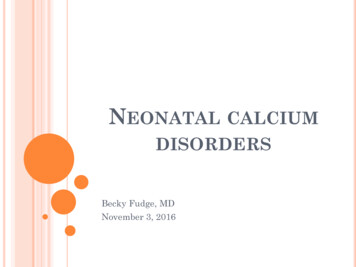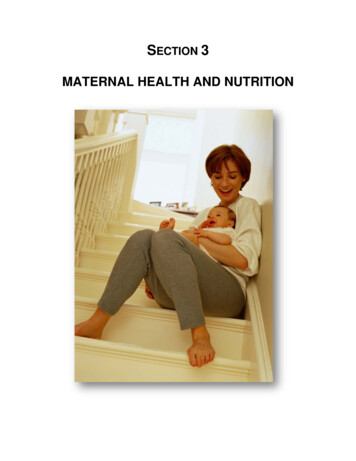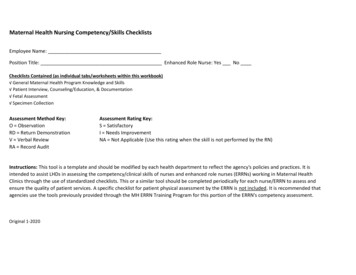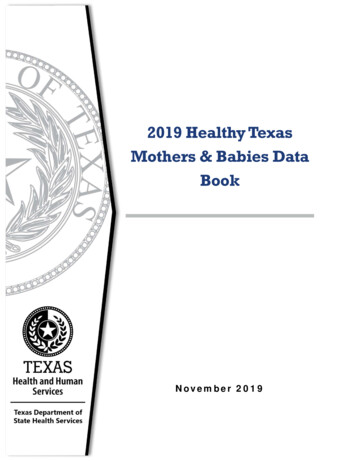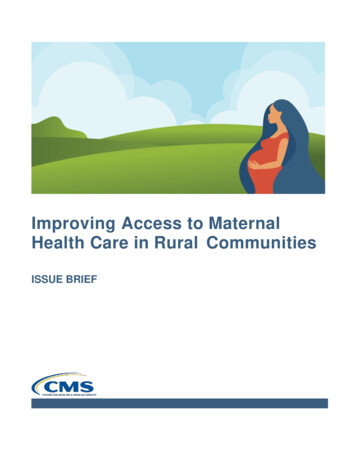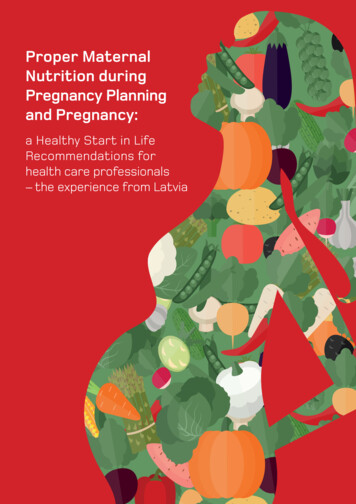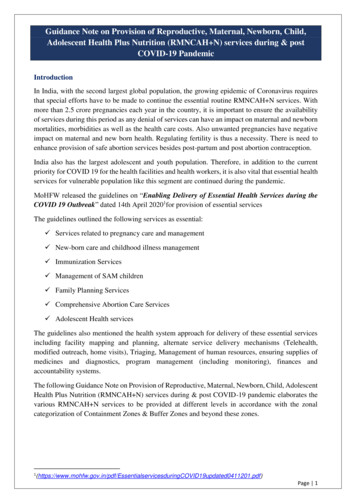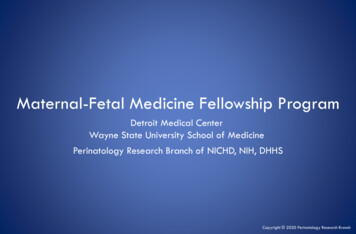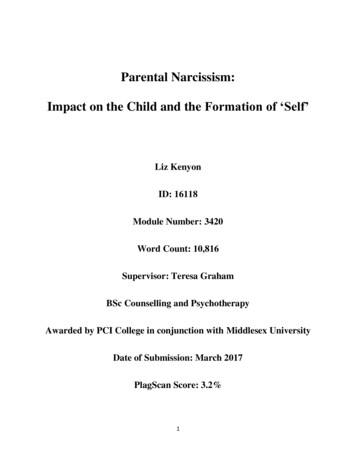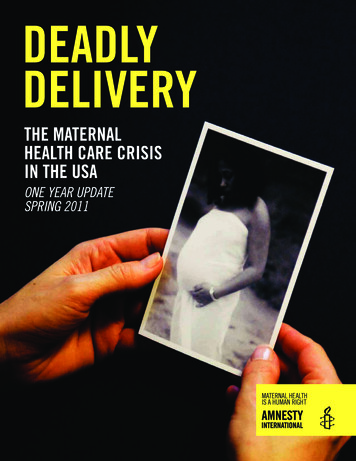
Transcription
MATERNAL HEALTHIS A HUMAN RIGHT
This document updates the report Deadly Delivery: The Maternal HealthCare Crisis in the USA (Index: AMR 51/007/2010) which contains fullcitations and should be consulted for further information.Cover photo, front:Tatia Oden French and her baby daughter, Zorah, died in 2001 after aninduced labor. Her mother has since set up a foundation to prevent similardeaths. Photo of Tatia Oden French taken by Joseph B. French and usedby kind permission of Maddy Oden and Joseph B. French. AmnestyInternationalAMNESTY INTERNATIONAL · DEMAND DIGNITY CAMPAIGN5 PENN PLAZA, 16TH FL · NEW YORK, NY 10001 · AMNESTYUSA.ORG/DEMANDDIGNITY · DEMANDDIGNITY@AIUSA.ORG
“It keeps startling me that at the beginning of this 21st century,at a time when we can . . . explore the depths of the seasand build an international space station, we have not beenable to make childbirth safe for all women around the world. This is one of the greatest social causes of our time.”Thoraya Obaid, Executive Director of the United Nations Population Fund1
“Amnesty International brought the issue of maternal mortality andOQTDKFKV[ HTQPV CPF EGPVGT CU C JWOCP TKIJVU KUUWG (QT VJG ƂTUV VKOG KP twenty years, I felt the American people come to understand the jeopardyof pregnancy and birth right here at home, understanding that thestatistics, perhaps unknown until now, are populated by our neighbors.”Jennie Joseph, Midwife, Winter Garden, Florida, 8 February 2011KEY DATA RELEASED IN 2010See Page 3According to new UN data, maternal mortality in the US has worsened,falling from 41st to 50th in the world. In other words, women in the US facea greater risk of maternal death than in 49 other countries.2See Page 3Over 4 million women in the US give birth each year, and the hospital billsfor this care reached 98 billion. International Federation of Health Plansdata indicated that the US spends twice as much as any other countrysurveyed on the fees charged by maternal health care providers.3See Page 5The US maternal mortality ratio, at 12.7 (deaths per 100,000 live births),was 3 times as high as the Healthy People 2010 goal, a national target setby the US government.4See Page 5The maternal mortality ratio for American Indian/Alaska Native women was4 times higher than the 2010 target and for African American women was 8times higher than the 2010 target.5See Page 7Women living in low-income areas across the US were twice as likely tosuffer a maternal death as women in high income areas.5See Page 8The US cesarean rate rose for the 13th consecutive year to reach an all-timehigh of 32.9% in 2009,6 more than double the WHO recommended range of5% to 15%.See Page 8New analysis shows that the states reporting higher than average cesareanrates (over 33% of births) had a 21% higher risk of maternal mortality thanstates with cesarean rates less than 33%.7
1“She never got to hold herbaby. That is one of thehardest things for me.”Above: A bulletin board at the DevelopingFamilies Center, a birth center in a medicallyunder-served community in Washingon, DC,covered with photos of the babies born towomen who received maternal health care atMatt Logelin, whose wife, Liz, died of a pulmonary embolism(blood clot) one day after giving birth by cesareansection to their daughter Madeline, now 3 years old8the center. Amnesty InternationalBACKGROUNDaccessing high quality maternal care.9On March 12, 2010, Amnesty Internationalissued a report entitled Deadly Delivery:The Maternal Health Care Crisis in theUSA, which documented that although theUnited States spends more on health carethan any other country, it ranked 41st (atthe time of publication) in terms of maternal death. As the report demonstrated, thisis not just a matter of public health, but ahuman rights issue. Half of these deathsare preventable, and the report clearlydemonstrated many barriers women face in2010 has been a watershed year for maternal health issues, both globally and in theUS. In 2010, new studies and data werereleased and new legislation and initiativesdeveloped that promise to improve maternal health. Throughout 2010, AmnestyInternational has been campaigning to endpreventable maternal deaths in the US andaround the globe. Despite some progress,more work remains to be done in order toensure that the work of the last year willhave a lasting impact. This update willexamine the developments and new dataon maternal health in the United States,address the expected impact on maternalhealth and health care of some key provisions in health care reform, the PatientProtection and Affordable Care Act, whichpassed on 23 March 2010, and coversome of the progress and successes thathave been accomplished during the lastyear. All data and developments cited inthis update have been released in 2010 or2011, except where indicated.MATERNAL HEALTH IS A HUMAN RIGHTAmnesty International Spring 2011
2DEADLY DELIVERYTHE MATERNAL HEALTH CARECRISIS IN THE USA: ONE YEAR UPDATEMATERNAL HEALTH IS AHUMAN RIGHTS ISSUEPreventable maternal mortality can resultHTQO QT TGƃGEV XKQNCVKQPU QH C XCTKGV[ QH JWman rights, including the right to life, theright to freedom from discrimination, andthe right to the highest attainable standardof health. Governments have an obligaVKQP VQ TGURGEV RTQVGEV CPF HWNƂNN VJGUG and other human rights and are ultimatelyaccountable for guaranteeing a health caresystem that ensures these rights universallyand equitably.6JG 75 JCU TCVKƂGF VYQ MG[ KPVGTPCVKQPCN human rights treaties that guarantee theserights: the International Covenant on Civiland Political Rights and the InternationalConvention on the Elimination of All Formsof Racial Discrimination. It has also signedtwo international treaties that addressthese rights—the International Covenanton Economic, Social and Cultural Rightsand the Convention on the Eliminationof All Forms of Discrimination againstWomen—and so has an obligation to refrain from acts that would defeat the objectand purpose of these treaties.According to human rights principles, thehealth care system must provide healthcare services that are available, accessible, acceptable and of good quality. Inaddition, the health care system must beaccountable, free from discrimination, andensure the active participation of women indecision-making.In June 2009, the UN Human RightsCouncil (HRC) issued a resolution explicitlyrecognizing preventable maternal mortalityas a human rights issue.10 6JG 70 1HƂEG QH MATERNAL HEALTH IS A HUMAN RIGHTAmnesty International Spring 2011HIGH LEVEL GLOBAL EVENTS IN 2010 SIGNALEDUNPRECEDENTED ATTENTION TO MATERNAL HEALTH.In September 2010, at the United Nation’s Millennium Development Goal Summit, the UNlaunched its Global Strategy for Women’s and Children’s Health, to identify and implementcritical interventions to improve maternal health and save the lives of over millions of womenand children by establishing a roadmap to improve maternal and child health.11As part of this effort, a new UN Commission on Information and Accountability for Women’sand Children’s Health has been established to create a framework to monitor globalcommitments for maternal, newborn and child health and to ensure that resources areused effectively, in order to save as many lives as possible. The Commission will proposea framework for global reporting, oversight and accountability on women’s and children’shealth.12Other high level global leadership efforts to reduce maternal mortality in 2010 includedinitiatives of the the G-8, the African Union summit, and the UN MDG summit. Humanrights bodies issued several resolutions and reports focused on maternal mortality andJWOCP TKIJVU KPENWFKPI C TGRQTV D[ VJG 1HƂEG QH VJG *KIJ %QOOKUUKQPGT QH *WOCP 4KIJVU a Human Rights Council resolution,13 and a resolution of the Inter-American Commissionon Human Rights. In addition, Women Deliver, a global advocacy organization, held itssecond conference on reducing maternal death with 3,400 participants from 146 countries,including UN and national government leadership.the High Commissioner on Human Rightsfollowed the resolution with a report furtherelaborating on the application of a humanrights-based approach to maternal mortality including: the need to focus on equalityand non-discrimination; obligations regarding accountability; and such elements asparticipation, transparency, empowerment,sustainability, and international assistance.The report made recommendations on howa human rights analysis can add value toexisting maternal health initiatives.14GLOBAL UPDATE*Around the world, a woman dies fromcomplications of pregnancy and childbirthevery ninety seconds, nearly 1,000 womenevery day.15Statistics released in 2010 demonstratethat when governments invest in improving maternal health, women’s lives can besaved.16 Yet, as reported by Countdown to2015 (a global initiative to track progresson maternal and child health), maternalmortality remains unacceptably high and
DEADLY DELIVERYTHE MATERNAL HEALTH CARECRISIS IN THE USA: ONE YEAR UPDATEmuch more work remains to be done.17 Thevast majority of maternal deaths occur indeveloping countries, and the vast majorityare preventable.18“The new evidence [of adecline in global maternaldeaths] is encouraging,but must not be allowedto undermine the urgencyof addressing maternalmortality and health asa basic human right.”Mary Robinson, President, Realizing Rights,former President of Ireland and United NationsCommissioner for Human Rights19New UN data show that between 1990and 2008, 146 of 172 countries reducedtheir maternal mortality ratios, for a globaldecrease of 34% to 358,000 deaths ayear. Some low and middle income counVTKGU JCXG DGGP CDNG VQ OCMG UKIPKƂECPV progress reducing maternal mortality byprioritizing the issue.20 Yet despite progress, the overall decline is less than halfof that needed to meet the United NationsMillennium Development Goal 5 target:reducing maternal mortality by 75% by2015. According to UN analysis, only 10countries are considered to be “on track”to meet MDG 5.21 Of all the MDGs, MDG 5is considered one of the least likely to bemet.22UNITED STATES UPDATEOVERVIEW US MATERNAL MORTALITYIn Deadly Delivery, Amnesty Internationaldocumented that women in the US face arange of obstacles in obtaining the servicesthey need, and documented multiple failuresin the health care system, including:FKUETKOKPCVKQP ƂPCPEKCN DWTGCWETCVKE CPF language barriers to care; lack of information about maternal care and family planningoptions; lack of active participation in careFGEKUKQPU KPCFGSWCVG UVCHƂPI CPF SWCNKV[ protocols; inadequate postpartum care; anda lack of accountability and oversight.*Previous UN reports showed thatwomen in the US have a greater risk ofdying of pregnancy related causes thanin 40 other countries. In 2010, UN datashowed that the United States had slippedfrom 41st to 50th, with a higher maternalmortality ratio than 49 other countries.23Women in the US face a greater risk ofmaternal death than nearly all Europeancountries, as well as Canada and severalcountries in Asia and the Middle East. Despite the 34% decrease in global maternalmortality between 1990 and 2008, with147 countries experiencing a decline inmaternal death rates, the US was amongjust 23 countries to see an increase inmaternal mortality.24MAGNITUDE AND COST OFMATERNAL HEALTH CARE*With over 4 million women givingbirth each year in the US, at a total costof 98 billion, childbirth and newborncare is by far the most common, and mostexpensive, reason for hospitalization.25*The International Federation of HealthPlans data reported in 2010 shows thatthe US spends twice as much as any othercountry surveyed on the fees charged bymaternal health care providers.26Deadly Delivery found that cost was aUKIPKƂECPV DCTTKGT RTGXGPVKPI YQOGP HTQO “While the decrease in the [global] maternal mortality ratio is a victory, it is anything buta ‘mission accomplished’. We are not off the hook The US still has a responsibilityto prevent maternal death. No woman should die giving birth, in the US or abroad. Wehave the technology and medical knowledge to prevent it. It’s just a question of makingsure everyone has access to it, which is, irrefutably, a basic human right.”Serra Sippell, President of the Center for Health and Gender Equity27MATERNAL HEALTH IS A HUMAN RIGHTAmnesty International Spring 20113
Above: The Safe Motherhood Quilt Project, anational initiative developed by midwife andauthor Ina May Gaskin to honor women whohave died of pregnancy-related causes since1982. Safe Motherhood Quilt Project“History will show that 2010was a year of new, decisiveaction—a year when theworld decided that no womanshould die giving life and nochild should die when weknow how to save them.”Ban Ki-moon, UN Secretary-General28MATERNAL HEALTH IS A HUMAN RIGHTAmnesty International Spring 2011accessing health care, with consequencesincluding women entering pregnancy withuntreated health conditions, facing delaysreceiving prenatal care and inadequatepost-partum care. Having a baby is themost costly health event families are likelyto encounter during their childbearingyears. Prior to health care reform, approximately 13 million women of reproductiveage had no health insurance. Uninsuredwomen are less likely to be in good healthwhen becoming pregnant, and if they havechronic health conditions, they are lesslikely to have obtained treatment, whichincreases their risks during pregnancy.Once becoming pregnant, women eligiblefor Medicaid (government funded healthinsurance for low income families) facedbureaucratic hurdles and delays obtaining Medicaid coverage, which resulted indelays obtaining prenatal care. In addition,many physicians do not accept payment byMedicaid because of low reimbursementrates, which has created a shortage ofproviders for women paying with Medicaid.The high cost of maternal care means thatmany women cannot afford to pay for carewithout insurance.Approximately 99 percent of women givebirth in hospitals where facility fees aloneaverage between 8,900 and 11,400 fora vaginal delivery, and between 14,900and 20,100 for a cesarean, dependingon whether complications occur.29 Thisdoes not include the health professionalfee which was reported in Deadly Deliveryto add an additional 4,350 to 6,000.Medicaid pays for over 40% of births inthe US, and costs related to pregnancy andbirth account for over one quarter of allhospital charges billed to Medicaid.30
DEADLY DELIVERYTHE MATERNAL HEALTH CARECRISIS IN THE USA: ONE YEAR UPDATE“The release of Deadly Delivery was a clarion call to action toreduce maternal death and improve maternal care in the US.It put a human face on our horrible statistics and struck anemotional chord among readers. It helped to mobilize us all!”Maureen Corry, Executive Director, Childbirth Connection, 14 February 2011MATERNAL MORTALITY DATADeadly Delivery found that maternal mortality in the US had not decreased in over20 years, and in fact, may be increasing.The maternal mortality ratio31 in the UScontinues to lag far behind the HealthyPeople 2010 goal, established by the USgovernment, to reduce maternal mortality to 4.3 deaths per 100,000 live births.According to data released in 2010, thematernal mortality ratio was 12.7,32 threetimes as high as the Healthy People goal.Despite the Healthy People Goal of reducing maternal mortality to 4.3 deaths per100,000 live births:***10 states had 18.5 or more maternaldeaths per 100,000 live births.33Only 5 states met the Healthy People2010 goal of 4.3 deaths per 100,000 livebirths.Maternal mortality ratios forAmerican Indian/Alaska Native womenand non-Hispanic black women were 4and 8 times higher than the 2010 target,respectively.*for White women, Latinas, and Asian#OGTKECP 2CEKƂE UNCPFGT YQOGP YGTG CNN approximately 2 ½ times higher than the2010 goal.34Photo: Julie LeMoult holds her baby boyshortly before her death in April 2003.Between 2003 and 2007, the averagematernal mortality has been 13 deaths per100,000 live births, approximately doublethe low of 6.6 deaths per 100,000 livebirths recorded in 1987.35 Although partlya result of improvements in data collection, this substantial increase remains aconcern.36In 2010, the Joint Commission (theprimary health care facility accreditationorganization) recognized “that maternalmortality rates may be increasing” andissued a Sentinel Event Alert on preventing maternal death, which recommendedparticipation in state-level maternal mortality review processes and other actions toprevent maternal deaths.37A report issued by the Centers for DiseaseControl and Prevention (CDC) in 2010found that pregnancy-related deaths(deaths related to pregnancy or childbirthin the year following pregnancy or birth)had reached their highest level in a 20 yearperiod.38 PrivateJULIE LEMOULT died on 4 April 2003after giving birth to a healthy baby boy– Logan Donnelly. She was given twoepidurals during labor. After giving birth,she complained of an intense headache,DWV JGT HCOKN[ EQWNF PQV ƂPF CP[QPG VQ help. When the headache worsened andshe developed a fever, the obstetricianordered an antibiotic over the telephone.Her husband says it was not administered.She started to have a seizure and wasrushed to intensive care, where doctorsdiscovered she had meningitis broughton by an infection—which led to massivebrain damage. Faced with the prognosisthat Julie would never recover from hercoma, her husband chose to take her offNKHG UWRRQTV *GT HCOKN[ ƂNGF C NCYUWKV against the hospital, charging that herdeath was the result of a “failure tomaintain a sterile environment.” Thehospital now requires physicians (andanybody else in the room) to wear a maskwhile administering an epidural.No racial or ethnic group metthe Healthy People goal: The ratiosMATERNAL HEALTH IS A HUMAN RIGHTAmnesty International Spring 20115
6DEADLY DELIVERYTHE MATERNAL HEALTH CARECRISIS IN THE USA: ONE YEAR UPDATEMATERNAL COMPLICATIONS(“MORBIDITY”)maternal complications.Deadly Delivery found that little data isavailable on maternal morbidity (complications), despite its frequency. “Nearmisses,” complications so severe thewoman nearly dies, have increased by over25% between 1998 and 2005 to 34,000Currently, nearly 30% of women experience complications related to childbirth,and this has not improved.40 The Instituteof Medicine, in a 2010 report requestedby Congress, determined that maternalmortality and morbidity were among theEQPFKVKQPU HQT YJKEJ TGEGPV UEKGPVKƂE research had achieved “little progress.” 41The Institute of Medicine concluded thatfuture research in this area should address“the promotion of wellness and quality oflife in women,” and that research on conditions that have high morbidity should beincreased.” 42“Maternal deaths are the tipof the iceberg for they are asignal that there are likelybigger problems beneath –some of which are preventable.It is important to considerthe women who get very,very sick and do not die,because for every woman whodies, there are 50 who areXGT[ KNN UWHHGTKPI UKIPKƂECPV complications of pregnancy,labor and delivery.” 39Dr. William M. Callaghan, Senior Scientist,Division of Reproductive Health, Centersfor Disease Control and PreventionC [GCT s QPG YQOCP GXGT[ ƂHVGGP OKPWVGU Over 1 million women a year experiencesome complication of pregnancy that has anegative effect on her health. Yet currently,researchers report that there is not enoughdata available to study how to reduce thesecomplications. Systems to measure qualityof care need to be put in place to ensurethat more research can be done to reduceMATERNAL HEALTH IS A HUMAN RIGHTAmnesty International Spring 2011RACIAL AND ETHNIC DISPARITIES*New government data shows thatfor 2005-2007, the maternal mortalityratio (deaths per 100,000 live births) washighest among non-Hispanic black women(34.0), followed by American Indian/#NCUMC 0CVKXG YQOGP #UKCP 2CEKƂE Islanders (11.0), non-Hispanic whites(10.4), and Hispanics (9.6).43Deadly Delivery found that women of colorare more likely to die in pregnancy orchildbirth than women from other sectionsQH VJG RQRWNCVKQP TGƃGEVKPI FKURCTKVKGU in access to health care and information,discrimination and inappropriate treatment,and socioeconomic disparities.New analysis conducted by the US government’s Maternal Child Health Bureau hasEQPƂTOGF CPF CFFGF VQ YJCV KU MPQYP about disparities based on income, race,ethnicity, and indigenous status.Photo: Maria and her one-year-olddaughter, 3 February 2009. PrivateMARIA (not her real name) did not haveaccess to public assistance during anyQH JGT ƂXG RTGIPCPEKGU DGECWUG QH JGT immigration status and so was unableto afford prenatal care. In 2008, whenshe went into labor with her last baby,the hospital she went to turned her awaybecause she had not received prenatalcare. The second hospital she visitedadmitted her. After six hours waiting tobe seen “I spoke to an interpreter via thephone because they wanted to check myinsurance. I asked him ‘Please, pleasesend someone please tell them thebaby is coming.’ Everyone spoke English.I was so afraid. At last a nurse came inand examined me”. Maria gave birth toher daughter, but soon after she beganto feel unwell. “I started crying out andscreaming, ‘I can’t breathe!’ Then I[passed out].” Maria was discharged afterthree days, but no one ever explainedwhat had happened. She did not receiveany follow-up care or get any of therecommended medications: “I had no wayto pay, so I never got any.”
DEADLY DELIVERYTHE MATERNAL HEALTH CARECRISIS IN THE USA: ONE YEAR UPDATE“Every effort should be made to ensure that the outcome of each and every labor and deliveryin the United States is a healthy newborn-mother tandem Determining the best waysto reduce maternal mortality and morbidity should have high priority in research.”Institute of Medicine, 201044The risk of maternal mortality has remained 3 to 4 times higher among blackwomen than white women during thepast 6 decades. Racial disparities werealso seen in all income groups, with blackwomen facing approximately three timeshigher maternal mortality risk comparedto white women at low, middle, and highincome levels.45“I think the U.S. was shockedby what they read [in AmnestyInternational’s report].”,KNN 5JGHƂGNF 2TGUKFGPV QH 9QOGP &GNKXGT a global advocacy organization calling foraction against maternal death46SOCIOECONOMIC DISPARITIES*In 2003-2007, women living in thelowest-income areas were twice as likely tosuffer a maternal death, and women in themiddle income areas faced a 58% higherrisk, compared with women in the highestincome areas.47*States with high rates of poverty(18% or more of people living belowthe poverty level) were found to have77% higher maternal mortality ratiosthan states in which fewer residents hadincomes below the federal poverty level.48Deadly Delivery found that low-incomewomen faced barriers to accessing careDG[QPF FKHƂEWNV[ RC[KPI HQT ECTG KPENWFKPI FKHƂEWNV[ QDVCKPKPI VTCPURQTVCVKQP EJKNF care, and leave time from work, as wellas shortages of health care providers andspecialists in their area.(QT VJG ƂTUV VKOG KP IQXGTPOGPV FCVC has been analyzed to show clear evidence ofsocioeconomic disparities in maternal mortality, by linking maternal mortality statisticsto census data on income level.49 Higherpoverty rates increased the risk of maternalmortality for both white and black women.50GEOGRAPHIC DISPARITIES INMATERNAL MORTALITY*State maternal mortality ratios variedfrom lows of 1.4 deaths per 100,000live births for Maine, and 4.3 deaths per100,000 live births for Indiana (lowestMMR for a larger state) yet reached ashigh as 26.0 for Michigan, and 41.6 forthe District of Columbia.51Deadly Delivery found that maternalmortality ratios vary considerably acrossVJG 75 YJKEJ OC[ TGƃGEV VJG UKIPKƂECPV differences in health care access, funding,Photo: Trudy LaGrew, a Native Americanwoman, died in Wisconsin in January 2008,three months after giving birth, followingsevere complications. Joseph LaGrewTRUDY LAGREW, a Native Americanwoman living on the Red Cliffreservation in Wisconsin, died on 7January 2008 from an undiagnosedheart problem, months after givingbirth to her second child. Althoughher pregnancy was considered highrisk because of complications duringher first pregnancy and obesity, TrudyLaGrew did not see an obstetrician orhigh risk specialist for prenatal carebecause the closest one was a two-hourdrive away.MATERNAL HEALTH IS A HUMAN RIGHTAmnesty International Spring 20117
8DEADLY DELIVERYTHE MATERNAL HEALTH CARECRISIS IN THE USA: ONE YEAR UPDATERQNKEKGU CPF UVCHƂPI KP FKHHGTGPV CTGCU Seven states and Washington, D.C. hadmaternal mortality ratios at least 50%higher than the national average of approximately 13 deaths per 100,000 livebirths,52 while eight states had maternalmortality ratios that were at least 50%lower than the average for the US,53 demonstrating the magnitude of this variation.Photo: Inamarie Stith-Rouse died in aBoston hospital in June 2003 after givingINFORMATION AND QUALITY OF CAREbirth to her daughter. Warning signs ofWhile cesarean births can be life-savingprocedures when needed, in the US,Deadly Delivery reported that cesareanbirths carry greater risks of death andsevere complications, compared withvaginal births. For example, cesareanshave been shown to increase a woman’srisk of infection, hysterectomy, and kidneyfailure, and have been associated with anincreased risk of developing a life threatening blood clot (pulmonary embolism).Cesareans also result in greater risks forfuture pregnancies. US experts and institutions including the Institute of Medicineand the CDC agree current rates are toohigh. The US government’s Healthy People2010 initiative set a goal of reducing thec-section rate to 15 percent for low risk,ƂTUV VKOG OQVJGTU *QYGXGT VJGTG KU PQ her decline were ignored. PrivateINAMARIE STITH-ROUSE, a 33-year-oldAfrican-American woman, delivered ahealthy baby girl, Trinity, by c-section ata hospital in Massachusetts in June 2003.Her husband, Andre Rouse, said that afterthe birth she was distressed and strugglingto breathe, but that staff dismissedtheir requests for help. Andre Rouse toldAmnesty International he felt race played apart in the staff’s failure to react.#EEQTFKPI VQ EQWTV RCRGTU ƂNGF D[ JGT family, it was hours before appropriatetests and surgery were undertaken, and bythen it was too late. Inamarie Stith-Rousehad suffered massive internal bleeding,and slipped into a coma. She died fourdays later. Andre Rouse said, “Her lastwords to me were, ‘Andre, I’m afraid.’”nationally-implemented, evidence-basedset of protocols or guidelines for the use ofmedical procedures in childbirth.54*New analysis shows that states withhigh cesarean rates (over 33%) wereassociated with a 21% higher maternalmortality risk.55Deadly Delivery HQWPF UKIPKƂECPV XCTKCVKQP from hospital to hospital and state to statein obstetric practice and the use of medicalprocedures across the country.In December 2010, the Maternal ChildHealth Bureau reported that “The rising trend in cesarean rates may have contributed to the apparent increase in maternal mortality during the past decade.”56This new analysis supports the need forincreased attention to the rising rates ofcesarean section and induction of labor.57*Recent data shows that the cesareanrate rose for the 13th consecutive yearto reach an all-time high of 32.9% in2009.58 The cesarean rate is now morethan double the WHO recommended rangeof 5% to 15%.The cesarean rate has increased everyyear since 1996, when it was 20.7% of all“Blaming women for the rise in maternal mortality, e.g., theyneed to take better care of themselves, will not solve thecurrent issues. Indeed, the bulk of the solutions that willhave the greatest impact are those solutions that occur at thesystem-level beyond the control of the individual woman.”Debra Bingham, Former Executive Director of the California Maternal Quality Care Collaborative, 28 February 2010MATERNAL HEALTH IS A HUMAN RIGHTAmnesty International Spring 2011
births, for a total increase of nearly 60%.Cesareans remained the most commonoperating room procedure in the US andwere performed on 1.4 million women in2009.59 The cesarean rate varied widelyacross states, from 22.8% in New Mexicoto 39.6% in Louisiana, and 48.0% inPuerto Rico, in 2009.60 On average, costsare higher for cesareans though they takemuch less time than a vaginal delivery,and recent studies have found that therate of cesareans varies by type of facilityCPF RC[GT HQT RTQƂV JQURKVCNU KP %CNKHQTnia had 17% higher cesarean rates thanPQV HQT RTQƂV JQURKVCNU CPF VJG EGUCTGCP rates highest for private insurance at 34%,somewhat lower for Medicaid at 30%, andlowest for uninsured women at 25%, suggesting the need for research to investigateKH RC[OGPV UVTWEVWTGU KPƃWGPEG ECTG FGEKsions.61Among the factors contributing to increasing cesarean rates is the decline in VBACsXCIKPCN DKTVJ CHVGT EGUCTGCP 5KIPKƂECPV barriers prevent many women from havingaccess to clinicians and facilities that areable and willing to offer a VBAC. Amongwomen who have had a cesarean in thepast, the rate of VBAC was only 9.7% in2006, a decrease of 73% from 1997 ratesof 35.3%, and new data for 19 statessuggests it may now be as low as 8%.62 InMarch 2010, in response to the high cesarean rates and because multiple cesareanspose an added risk of complications, theNational Institute of Health held a conference on VBAC, which found that “given theavailable evidence, [VBAC] is a reasonableoption for many pregnant women,” andthat when it is a safe option, “wheneverpossible, the woman’s preference shouldbe honored.” The panel recommended thatfacilities, providers, consumers, insurersPhoto: A rally in 2004 in Frederick, Maryland,calling for the reversal of a recent hospitaldecision to ban vaginal births after a priorc-section (VBAC). After 18 months o
2010 has been a watershed year for mater-nal health issues, both globally and in the US. In 2010, new studies and data were released and new legislation and initiatives developed that promise to improve ma - ternal health. Throughout 2010, Amnesty International has been campaigning to end preventable maternal deaths in the US and around the globe.
